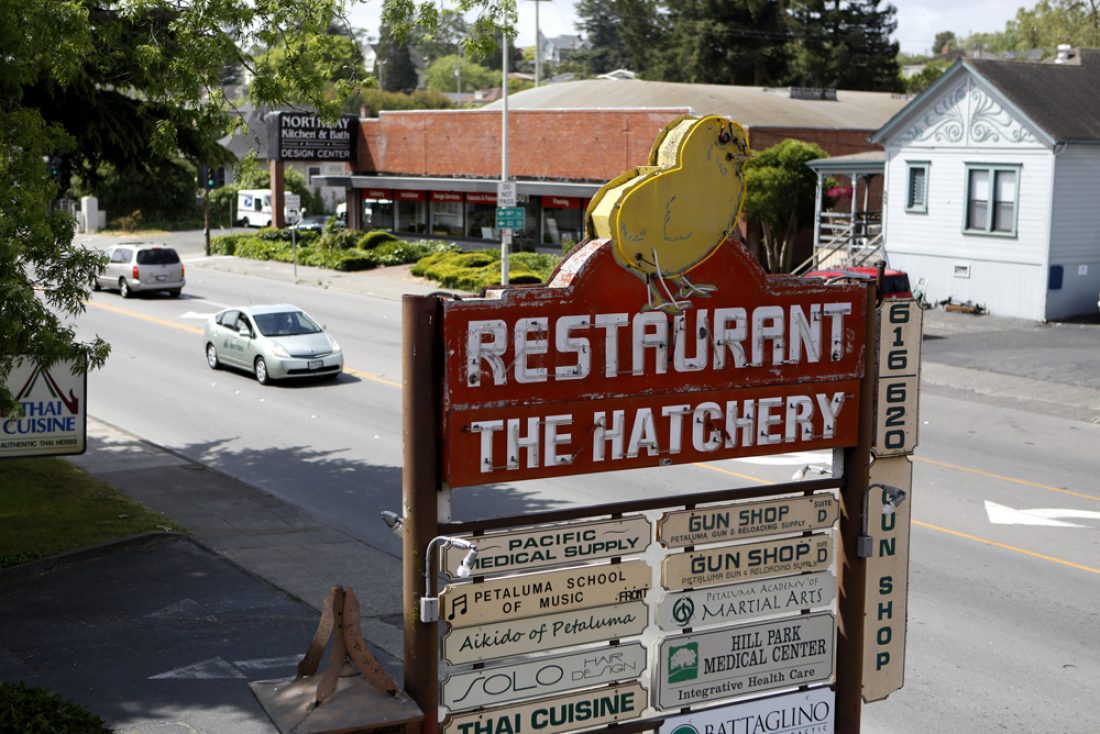By KATIE WATTS / Petaluma Towns Correspondent
Because of its location at the top of the bay, Petaluma was a natural hub for early day Sonoma County travelers. Whether arriving by river, train or car, they could continue east to Sonoma and the mission, northeast to Santa Rosa or northwest to the farming country and the retreats along the Russian River.
When Petaluma was still known as the World’s Egg Basket, motorists could follow the Old Redwood Highway through downtown and then north, passing hatcheries, schools, auto courts and mills, the plain side of town that kept life moving.
Two eye-catching portals of the past still exist on Petaluma Blvd. North: Cinnabar Theater, which began as a school, and the old Poehlmann Hatchery at 620 Petaluma Blvd. North. It’s the brick building with the old neon sign in front that reads “Restaurant — The Hatchery” and features a neon chick.
In 1918, Frank Poehlmann, in partnership with his wife Bertha and son Max opened the hatchery. The family lived at 610 Main, the fancy Victorian next door that now houses Thai Cuisine.
Max continued the business after his father’s death in 1922, growing it into one of the town’s largest hatcheries, incubating and producing up to a million chickens per year. Clay Thompson, Max Pohelmann’s nephew, took over the business in 1959 and sold it in 1975. The building was remodeled in 1979 and currently houses about a dozen small businesses.
Lucy Garcia enjoys the elderly customers she meets at Pacific Medical Supply, which has an office in the rear of the building. “They talk about things like when they used to kill chickens up there,” and she gestures toward the front of the building.
Fellow employee Denise Adamson has other stories. “I’m sensitive to spirits,” she says. “Two or three times I’ve seen a man in overalls in the back.” He’s dressed in clothing from the 1920s or ‘30s, she says, but emphasizes “he’s interesting, not scary.
“There’s nothing negative or frightening. He’s just a residual haunt,” she believes. “Doing the job he did for who knows how long.” Employees hear odd noises and things fall off shelves, she says, but no one’s frightened.
Nancy Dibble has been a hairstylist for six years at Solo Hair Design another tenant of the Hatchery. She said that it is a wonderful old building with Modern HVAC. She has also said that “It’s a good vibe to work in.”
Dr. Steve Battaglino of Battaglino Family Chiropractic is next door. “The business was growing,” he says, explaining his decision to rent the space. “I enjoy the good energy and light. It’s a charming place.”
His assistant, Jennifer Arrington, introduces herself as longtime Argus-Courier columnist Bill Soberanes’ niece. She says, “When I walked up the stairs for the first time, it was like coming home. I could see my grandma’s friend’s house out the window.” And, she adds, “the patients say it feels homey as well.”
As distinctive as the neon chick is the Mission Revival roofline of Cinnabar Theater, on a hilltop at 3333 Petaluma Blvd. North. The style is an homage to the California’s missions.
It was built in 1908 as Cinnabar School and consisted of two rooms and a connecting room used as a library, with a wood-burning furnace in the basement and pot-bellied stoves in each room. A windmill pumped water from a nearby well.
“It is modern in every particular,” reported the Argus of the school’s Aug. 27, 1908 dedication, “being a one-story building with a large basement for the use of the children in rainy weather. The building will be used for the first time next Monday when the fall term of school will begin. The old teachers will be in their accustomed places and a very successful year is hoped for.”
In 1958, the building was sold to the Eagles Lodge when a new Cinnabar School opened on Skillman Lane. And in 1970, Marvin and Jan Klebe bought it.
Marvin was an opera singer who “turned his back on his Bay Area career because he didn’t want to be a cog in somebody else’s wheel,” recalls his widow, Jan.
“He sang in some very large places, which he hated. He wanted to communicate not just the music, but the dramatic part of opera. He realized true performing artists needed a place to do their work, and he wanted to make the space available to other performing arts.”
At first, she says, the couple intended to move away. “But I knew Marvin couldn’t give up opera. When he was asked to direct an opera at Sonoma State, he stepped back into the professional world.”
He and a friend talked about how they would do opera if they had their own company.
“I wasn’t going to listen to them talk about what they would do, if . . . So we bought this when we realized we could live here, build a shop and be self-supporting.”
Marvin Klebe also was a cabinet maker, and for years the family funded the opera with proceeds from his business.
Jan says she and Marvin and their four sons rebuilt the old school into a theater. Its redwood siding was so decrepit a coat of stucco had been added. The Klebes gave the building its first coat of the distinctive cinnabar-red paint.
“We are part of a continuum,” says Cinnabar’s Artistic Director Elly Lichenstein, “connecting the thread of the past through the present to the future. We live the dream Marvin and Jan set out to do.”
Read about key stops along those early day Sonoma County roads in the special May 12 issue of Towns:
Windsor’s roadhouse with a reputation and Mark West market
Cloverdale’s barnside medical advertisement
Penngrove’s ‘Electric Hatchery’
Guerneville’s former Murphy’s Guest Ranch
Stewarts Point to Point Reyes Station: The winding legacy of Highway 1

